Genre: Action Developer: Taito Publisher: Taito Players: 1 Released: 1991
Before Capcom completely overtook the arcades with Street Fighter II, players got their violent needs sated with side-scrolling beat-’em-ups like Double Dragon and Final Fight. Along the same vein were other brawlers that limited the players to solely vertical and horizontal movement. These had long been a staple of the arcade scene, and companies such as Data East and SNK made their presences known with hits such as Bad Dudes and P.O.W: Prisoners of War. Arguably, one other publisher was among this elite company, and it perhaps had a better grasp of the side-scrolling action genre than any of its rivals. Taito, whose coin-op legacy is legendary, was quite adept at producing simple, yet fun machines to suck away our free time (as well as our money).
One of that company’s most famous action titles was Thunder Fox, which allowed two players to simultaneously save the world from evil terrorists. Personally, I’m still waiting to run into a friendly terrorist, and while I doubt they’re out there, I’m willing to keep an open mind. Regardless, the terrorists in this game are undoubtedly evil, which means that there are miles of side-scrolling stages for agents Thunder and Fox to cover and an infinite amount of identical bad guys for them to kill, each with a single blow.
Don’t you just love those old arcade games from the ’80s and early ’90s? Talk about pick up and play! All one need do is walk right and kill everything that moves. Thunder Fox adheres to this formula rigidly and executes it like clockwork. Stiffly-animated villains gang up and overwhelm the player with sheer numbers instead of ability, weapons, while incredibly lethal, disappear after they run out of ammunition, and par for the course, the enemy itself provides the very means of its undoing by offering up guns and grenades for instant use. I honestly think that the major arcade publishers all agreed on a standard action game design and just passed out the diagram among all their developers. If you’ve played any of the titles I mentioned above – or dozens of others like them – then you’ve played Thunder Fox.
Unfortunately, the Genesis port is much, much less worthy of fanfare than its arcade sibling. The differences go much beyond the aesthetic, though that’s perhaps the first thing gamers will notice. Beyond the washed out and blandly-colored graphics lies a game that has been virtually neutered almost to the point of irrelevance. I may sound a bit harsh, but when one compares this version to its source material, what made the original so much fun has taken a major hit.
First off is the omission of the two-player mode. The Genesis game is a solo affair, and that’s pretty weak for a conversion that still retains the scene of both agents in its attract mode. Taito made a weak attempt to work around this by letting the player choose either of the two heroes, but it really makes no difference. Both are virtually the same in gameplay (though the manual makes the distinction that Thunder is supposedly better with firearms and Fox is tops with the knife), and the whole reason there are two of them is so that two people can play simultaneously. Removing the second player option reduces whatever fun there is to be had by a large margin. And everyone knows that killing evil terrorists is something best done with a friend!
Another knock against this port is the fact that Taito removed several stages, namely the vehicle ones. No longer can players zip around among the clouds in the autogiro or skip past soldiers on their jet skis. Moreover, the five stages that remain have been critically altered. There are no jeeps to drive, and the mid-stage bosses have been removed entirely. This of course, goes hand-in-hand with the simplified visuals. No more rain or lightning bolts to be found here.
To compensate for the massive trauma Thunder Fox suffered during its home conversion, Taito made the stages a bit longer. This was most likely done to try and extend the game’s play time as much as possible, given just how much was cut out. Sadly, it doesn’t work at all, and the stages tend to drag on far longer than they should. Worse, they’re timed, which means that players can’t take their time to reach the boss at the end.
One thing Thunder Fox does emulate quite well from the arcade version is its brutal difficulty. Expect to die often here, and this port only allows five continues. Considering how long the stages are and how hard the game is overall, only those who are patient enough to learn the enemies’ patterns and the best time to use each weapon are likely to see the final boss. Even fewer will see the ending without a Game Genie. Most arcade games of the era were like this anyway, and the unlimited continues were only there to keep players shoving quarters for as long as possible. On the Genesis, no such requirement exists, so players will have to make do with the limited continues.
Thunder Fox is a game that was great in the arcade and decidedly worse at home, much like most of the other conversions of the era. It’s a vivid reminder of when home consoles didn’t usually know what “arcade perfect” was, and unlike other games on the Genesis, such as Moonwalker and ESWAT, which overcame this obstacle by offering versions that are different yet arguably better, Thunder Fox ended up being a watered-down, straight port that’s as still quite playable. The sad part is that it’s also quite forgettable.
SCORE: 4 out of 10


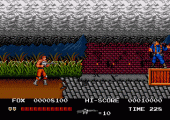
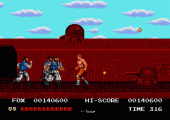
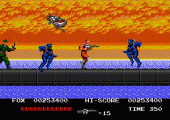
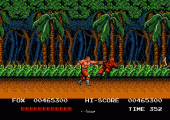
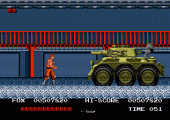
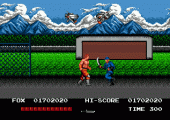
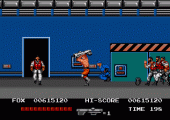
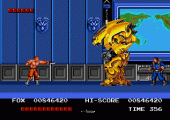
Recent Comments